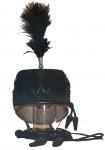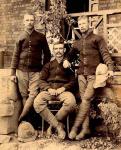-
Posts
1,761 -
Joined
-
Last visited
-
Days Won
3
Content Type
Profiles
Forums
Blogs
Gallery
Events
Store
Everything posted by Stuart Bates
-

Home Service Helmet
Stuart Bates replied to paul w's topic in Great Britain: Militaria: Badges, Uniforms & Equipment
I forgot to add that the helmet plate seems offset to the left - looking front on - I doubt that this would have been acceptable. -

Home Service Helmet
Stuart Bates replied to paul w's topic in Great Britain: Militaria: Badges, Uniforms & Equipment
Paul, I wouldn't touch this one, it is just not right - 1. The four arm base of the spike doesn't sit properly on the helmet and is secured by only two lugs with cotter pins! The correct method is a screw thread on each arm secured by a washer/nut. There doesn't seem to be evidence of the other two holes required. 2. The base of the spike intrudes far to far into the interior of the helmet. It should be level with the cartwheel collett. The spike is obviously not for a Home Service helmet. 3. The helmet plate does not sit well on the helmet. It looks like there are four holes penetrating the helmet shell to secure the plate. There should only be three - at mid-right and mid-left on the backing plate and one from the backing plate's detachable centre. Lugs and cotter pins/leather wedges were used to secure the plate to the helmet. Hope this helps. Stuart -
This has to be Queen Victoria's funeral as note the use of the white Colonial Pattern pith helmet. This was replaced by the Wolseley over the first few years of the decade. I have to wonder why it is being worn at all in England as it was a Foreign Service helmet and you can see the Blue Home Service helmet also being worn. Queen Vic's funeral was held on the 2nd February 1901 and looking at the trees devoid of foliage one would have to say this is a winter photo. Edward VII's funeral was held on the 20th May 1910 so I think it reasonable to expect the trees being in bloom. Stuart
-

Mystery badge.
Stuart Bates replied to Gordon Williamson's topic in Great Britain: Militaria: Badges, Uniforms & Equipment
-

Mystery badge.
Stuart Bates replied to Gordon Williamson's topic in Great Britain: Militaria: Badges, Uniforms & Equipment
Gordon, this probably doesn't help but I found a cap badge with slider but no scroll. It has the cypher of George V and the accompanying description says "The Military Provost Staff Corps. Brass 1936-1953." Obviously the date range is for George VI but the lack of a scroll may be significant. Stuart -

Mystery badge.
Stuart Bates replied to Gordon Williamson's topic in Great Britain: Militaria: Badges, Uniforms & Equipment
Could be Military Police. Their cap badge was the same but with a scroll underneath bearing the department's title of the day e.g. Royal Military Police for QEII. -
Mervyn, this is a very good question. Leather helmets and components of helmets were, as you know, common in armies of the 18th/19th Centuries. I guess that it was cheaper than metal, maybe lighter, and did afford reasonable protection from glancing sword cuts. The Lancer Caps were an early phase of my collecting - late '90s. I would not consider attempting any restoration myself and certainly not just for a bit of "bubbling" of leather. If I were in England I would certainly send a couple of items to a restorer. For example, a rather nice Wolseley has leather rot to the brim edging and I would have that fixed. But, generally speaking, I try to buy items that don't need it. The question about the swans' feathers was prompted because I remember that someone wanted to have a plume restored but was refused by the restorer because the Queen owned the swans and their feathers (guts and gizzards too I presume). I am sure that they could have been sourced elsewhere. It comes from times when the swan was a regular on the banquet tables of royalty. Apparently the Queen owns only the mute swans on the Thames. Mute because they don't say much! Stuart
-
Time for a change so here is my 9th Queen's Royal Lancer Cap. It is of the 1856 pattern and features the cypher of Queen Adelaide, consort of William IV. The regiment amalgamated with the 12th Lancers in 1960. Also notable is the corded chinchain, the four gilt metal ornaments at each corner of the trencher top, the gilt metal strips covering the angles of the top, and the metal band around the waist of the cap. The top is also unique for Lancer regiments in being of patent leather rather than fabric. It is not clear from this photo but the plume was of black swan feathers over white.
-
Hi Will, I am trying to contact Ian Knight, a noted expert on the Zulu war, as it is his Osprey book that has so many illustrations of a 4 seam FSH. He is a member of the Victorian Military Society, as am I, so I have sent in a letter to the editor. I also contacted Mike Snook, who, for me, wrote the definitive book on Isandlwana. We had a short but charming dialogue where he says that his area is tactics and strategy rather than equipment. I will keep plugging away. Stuart
-
Unless I am mistaken I have seen photos of this one. It is a Wolseley modified by the removal of the ventilator and the consequent stopping up of the vent. Presumably to prevent gas from entering the helmet shell. It has a fitted hood all around into which is let a glass arrangement not dissimilar to a scuba face mask. There is also a fixture which takes a tube to supply air into the helmet but from where? A tank containing Oxylithe (sodium peroxide or sodium dioxide which absorbs carbon dioxide and emits oxygen) may have been used. If it is indeed Royal Engineers then a tube attached to a compressor may have been used for such things a mine rescue i.e. a collapsed or destroyed sap. It is obviously an attempt to provide protection from gas but, obviously, not too many were made. Unless someone on the forum can ID this I suggest enquiries to the NAM or the Royal Engineers Museum. Stuart
-
Leigh, it's just their use of English. They are saying that the helmet is black cloth covered rather than white. They were not responsible for producing "covers". In fact most of what they say is a direct take from the 1883 DRs with some additions of their own. Stuart PS. I sent a question as to which regiments were allowed this helmet to the NAM.
-
Peter, that does not negate the fact that 4 seam helmets were available from British sources, albeit not regulation but rather "mufti." The illustrator, in that Osprey Book British Forces in Zuland 1879, Richard Scollins shows all helmets with 4 seams and with holes for the helmet plate and this cannot be correct. I will attempt to contact either the author and/or the illustrator. Stuart
-
OK!!!! I found this in William Jones & Co's, Army & Navy outfitters, catalogue of 1886 - Helmets for India and Foreign Service - The usual description of white , 6 seams etc. but "Rifle Regiments, as above with bronze furniture; some Rifle regiments have been allowed to wear their helmets covered black cloth, instead of white." I hope this puts this thread to bed Stuart
-
Here is a rather nice photo of 3 soldiers of the Gloucestershire Regiment. It clearly shows the neck curtain and the back badge. What is very interesting here is that the neck curtain seems to be held in place by the puggaree rather than being simply tied on. Regular battalions wore the brass back badge tucked into the cloth patch. Photo Courtesy Soldiers of Gloucestershire Museum







